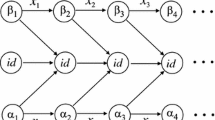Abstract
In the setting of symbolic dynamics on discrete finitely generated infinite groups, we define a model of finite automata with multiple independent heads that walk on Cayley graphs, called group-walking automata, and use it to define subshifts. We characterize the torsion groups (also known as periodic groups) as those on which the group-walking automata are strictly weaker than Turing machines, and those on which the head hierarchy is infinite.


Similar content being viewed by others
Notes
In the earlier article (Delorme and Mazoyer 2002), essentially the same observation is made in a slightly different setting on the group \(\mathbb {Z}^2\).
This is a group because by the compactness of X, the inverse of a CA is continuous, and the inverse of a bijection commuting with a group action is easily seen to commute with the group action.
The term ‘recursively presented’ comes from the fact that one may assume \(\{ w_i \;|\; i \in \mathbb {N}\}\) to be a recursive set of words.
Turing machines can do this on any group, as they can modify a configuration and create a tape for themselves. Our finite-state automata fail in this task on torsion groups, by Theorem 6.
Note that here we use the fact that \(x_{1_G} \ne 0\). In general, we can only conclude \(f^{n+m}(x) = \sigma ^R_h(f^n(x))\) for some \(h \in B_G((q + 1)r)\).
The fact that G is torsion prevents us, in general, from defining a bijective version of \(\phi\). Also, the subshift \(Y'\) may be strictly smaller than Y.
References
Adian SI (2011) The Burnside problem on periodic groups and related questions. Proc Steklov Inst Math 272(2):2–12
Aubrun N, Barbieri S, Sablik M (2014) A notion of effectiveness for subshifts on finitely generated groups. ArXiv e-prints 1412.2582. Preprint
Blum M, Hewitt C (1967) Automata on a 2-dimensional tape. In: Switching and automata theory, 1967. SWAT 1967. IEEE conference record of the eighth annual symposium on, pp 155 –160
Ceccherini-Silberstein T, Coornaert M (2010) Cellular automata and groups. Springer monographs in mathematics. Springer, Berlin
Delorme M, Mazoyer J (2002) Pebble automata. figures families recognition and universality. Fundam Inf 52(1–3):81–132
Grigorčuk RI (1980) On Burnside’s problem on periodic groups. Funktsional Anal i Prilozhen 14(1):53–54
Gupta N, Sidki S (1983) On the burnside problem for periodic groups. Math Z 182(3):385–388
Jeandel E (2015) Aperiodic subshifts of finite type on groups. ArXiv e-prints 1501.06831. Preprint
Lind D, Marcus B (1995) An introduction to symbolic dynamics and coding. Cambridge University Press, Cambridge
Monien B (1980) Two-way multihead automata over a one-letter alphabet. RAIRO Inform Théor 14(1):67–82
Salo V, Törmä I (2014) Plane-walking automata. CoRR. abs/1408.6701
Salo V, Törmä I (2015) Group-walking automata. In: Kari J (ed) Cellular automata and discrete complex systems, vol 9099, Lecture notes in computer science. Springer, Berlin, pp 224–237
Schroeppel R (1972) A two counter machine cannot calculate 2N. AI Memo 257. MIT Artificial Intelligence Lab, Cambridge
Tointon MCH, Yadin A (2016) Horofunctions on graphs of linear growth. CR Math 354(12):1151–1154
Yao AC, Rivest RL (1978) \(k+1\) Heads are better than \(k\). J Assoc Comput Mach 25(2):337–340
Acknowledgements
Research supported by Comisión Nacional de Investigación Científica y Tecnológica, FONDECYT Grant 3150552 (Ville Salo).
Author information
Authors and Affiliations
Corresponding author
Rights and permissions
About this article
Cite this article
Salo, V., Törmä, I. Independent finite automata on Cayley graphs. Nat Comput 16, 411–426 (2017). https://doi.org/10.1007/s11047-017-9613-6
Published:
Issue Date:
DOI: https://doi.org/10.1007/s11047-017-9613-6




